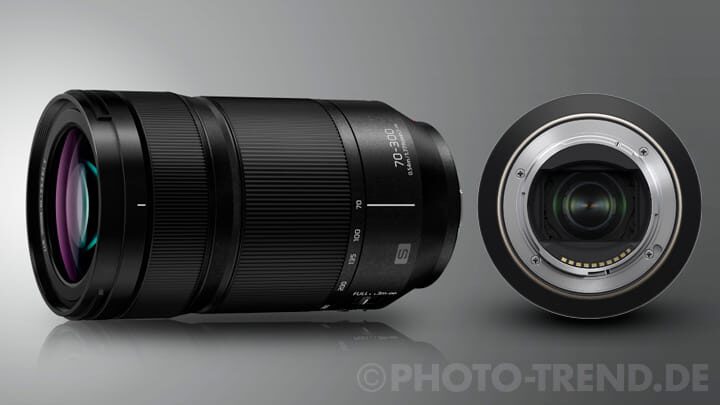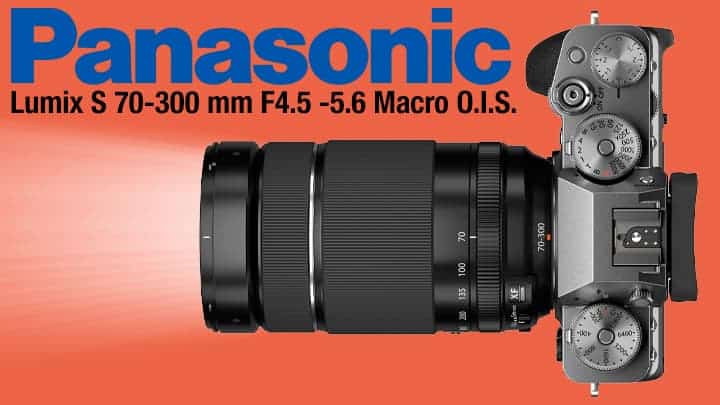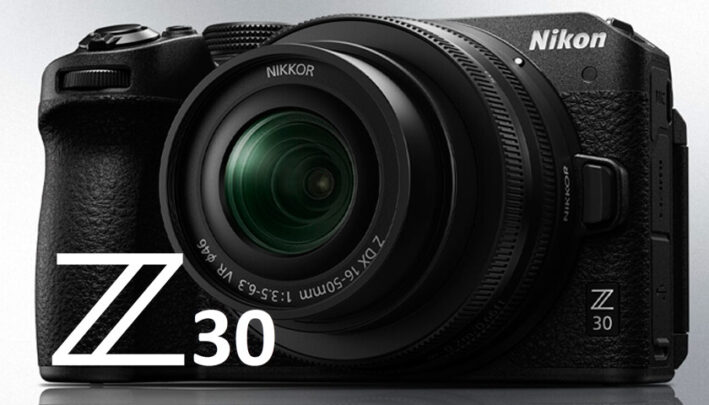Hits: 12
With this new telephoto zoom, Panasonic is enriching its L-mount lens program with a lens that meets all the requirements for a bestseller.
It is astonishingly light and compact, but still looks valuable and well made and fits perfectly with the character of the Lumix S5. We are talking about the newest member of the L-mount lens family from Panasonic, the Lumix S 70-300 mm F4.5-5.6 Macro O.I.S. At just under 800 grams, the telephoto zoom is very handy and, together with the Lumix S5, is very well-balanced in the hand, even when fully extended to a focal length of 300 millimeters. The operating rings for focal length and sharpness run smoothly and smoothly with a defined resistance.
Macro function
Of course, as is usual with Panasonic, the lens is sealed against dust and splash water, a fluorine coating on the front lens repels oil and water and makes cleaning the lens surface particularly easy. So much for the standards, now for the special features – and there are quite a few of them. First of all, the remarkably short close-up limits of 54 cm at 70 mm focal length and 74 cm at 300 mm focal length stand out.
The Lumix S 70-300 mm F4.5-5.6 Macro O.I.S. to the macro lens with a large escape distance. In other words, it creates macro shots at half natural size (maximum magnification 0.5) without, for example, bothering an insect too much – and thanks to the image stabilizer, this is still out of hand.

The optical image stabilizer in the O.I.S. works in the so-called Dual I.S. Mode together with the camera’s sensor shift image stabilizer IBIS. Both systems complement each other, with the optical stabilizer dominating for long focal lengths. Panasonic gives the Lumix S 70-300 mm F4.5-5.6 Macro O.I.S. a gain of 5.5 EV levels, although we had the impression in the test that they wanted to be on the understatement side.
In practice, with a focal length of 300 mm, sharp images with times of 1/20, sometimes even 1/10 of a second, can be taken at a very short distance in macro mode as well as in the telephoto range without great effort, which can be described as really exceptionally good. The lens was able to show its very good sharpness to the full. The autofocus provided excellent support and worked quietly, accurately, inconspicuously and reliably.
Construction
Panasonic paid particular attention to the construction of the Lumix S 70-300 mm f / 4.5-5.6 Macro O.I.S. For the best possible bokeh. Instead of the nine aperture blades usual with high-quality lenses, the new telephoto zoom was given eleven aperture blades in order to achieve an ideal approximation of a homogeneous circle. Aspherical lenses have been identified as harmful to homogeneous blurring circles, which in Panasonic jargon then become noticeable as an onion effect, which is probably an onion ring look.
As a result, these were completely dispensed with in the total of 17 lenses in eleven groups. Instead, they use particularly high-quality glasses, including two ED and one UED lenses with low dispersion and a UHR lens with particularly high refractive power.

The image quality
Chromatic aberration and distortion: The lens does not even know color errors. Slight barrel-shaped geometric distortions are only vaguely indicated, if at all, and are very well corrected.
Vignetting: Interestingly, the lens shows at a focal length of 300 millimeters and an open aperture of f / 5.6
a slight decrease in brightness towards the outermost corners of the image. which is about one stop level, but a slight stop down removes this vignetting for the long term. With all other focal lengths, the vignetting is only very slight, if at all.

Bokeh: All the measures taken have clearly paid off here. The Lumix S 70-300 mm f / 4.5-5.6 Macro O.I.S. shows an extremely beautiful and soft bokeh at all focal lengths, even from 70 mm, which it recommends as a portrait lens – despite the relatively low light intensity. In the increasing telephoto range, the exemption effect is of course more pronounced and spectacular. Here the transitions from sharpness to blurring are always smooth and harmonious.
Image sharpness: When the aperture is open, the lens on the Lumix S5 delivers excellent to outstanding sharpness in the center of the image for all focal lengths. The sharpness decreases only slightly towards the edges of the image with an open aperture. From an aperture of f / 5.6 in the focal length range of 70 to 200 mm, the sharpness increases to outstanding (10 points) over the entire image field. At 300 mm, the sharpness in the center of the image is always outstanding and always very good at the edges of the image, the best aperture here is f/11.
Conclusion
The Lumix S 70-300 mm f / 4.5-5.6 Macro O.I.S. is an excellent telephoto zoom with an extended telephoto range and excellent macro properties. It is extremely sharp, has a very good image stabilizer and offers an excellent price-performance ratio.
Technical data / equipment
Manufacturer: Panasonic
Internet: www.panasonic.com English
Price (RRP) € 1,350
Lens type: telephoto macro zoom
Lens bayonet: L-mount
Focal length: 70-300 mm
Light intensity: f / 4.5-5.6
Lenses / groups: 17/11
Smallest aperture: 22
Sealed bayonet: Yes
Splashproof: Yes
Auto focus: Yes
Image stabilizer: Yes
Closest focusing distance: 54-74 cm
Max. Magnification: 0.5 at 300 mm
Aperture blades: 11
Filter diameter: 77 mm
Lens hood: Yes
Lens case: No.
Dimensions (Ø x H): 84 mm x 148 mm
Weight: 790 g




